Drone-powered crowd safety is transforming event monitoring with cutting-edge aerial surveillance. You'll benefit from real-time bird's-eye views that enhance crowd management and security. High-resolution cameras and thermal imaging help identify risks quickly, while AI analyzes crowd movements to detect potential threats. These innovations enable swift response coordination, guiding emergency personnel to precise locations. Drones can cover vast areas silently, maintaining the event atmosphere while providing essential data. They're also equipped to handle low-light conditions and locate lost individuals. As this technology evolves, it's reshaping how events are managed, promising safer experiences for attendees. Discover how these airborne guardians are revolutionizing event security.
Aerial Surveillance for Event Security
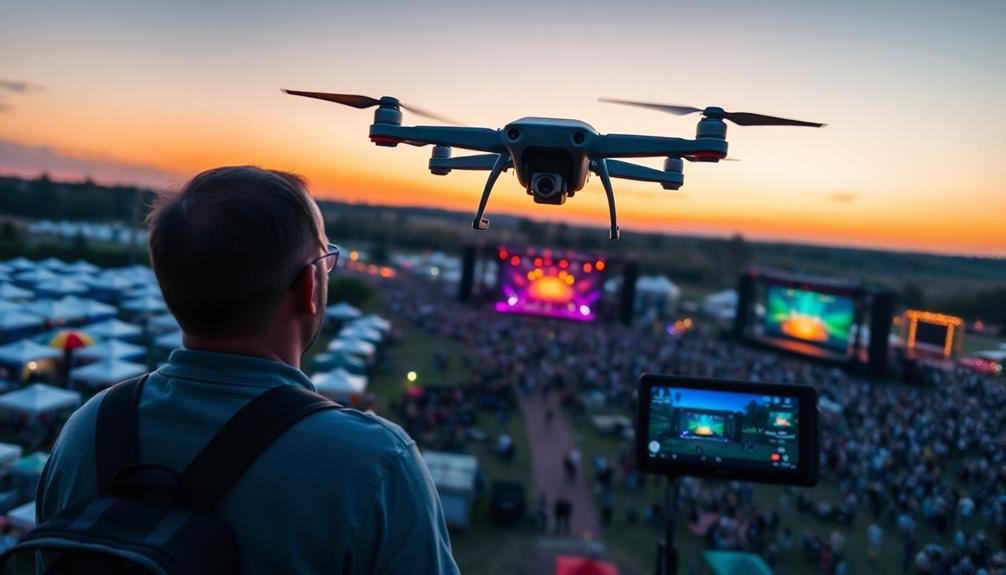
At the forefront of modern event security, aerial surveillance using drones has revolutionized crowd management and safety protocols. You'll find these unmanned aerial vehicles hovering above large gatherings, providing real-time bird's-eye views of the entire event area.
They're equipped with high-resolution cameras and thermal imaging technology, allowing security teams to monitor crowd movements, identify potential risks, and respond swiftly to emergencies.
You can expect drones to patrol the perimeter, detect unauthorized entries, and track suspicious activities. They'll help you maintain a thorough situational awareness that ground-level security alone can't match.
With their ability to cover vast areas quickly, drones enable rapid assessment of crowd density, flow patterns, and potential bottlenecks.
You'll benefit from their silent operation and inconspicuous presence, which won't disrupt the event atmosphere. They're particularly useful in hard-to-reach areas or during low-visibility conditions.
Real-Time Crowd Density Analysis
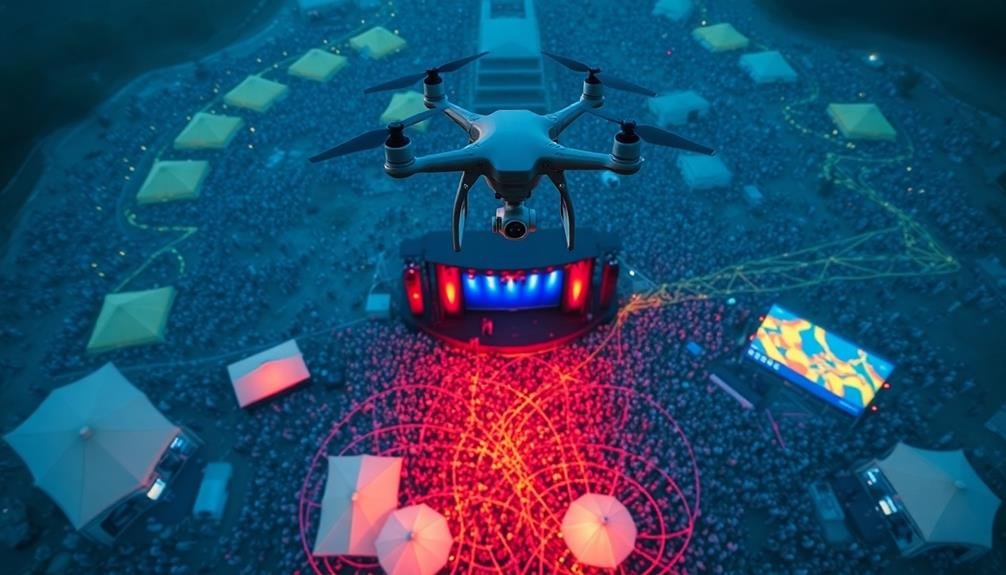
Building on aerial surveillance capabilities, real-time crowd density analysis takes event security to the next level. Using advanced image processing algorithms, drones can now analyze footage in real-time to estimate crowd sizes and densities across various event areas.
You'll benefit from this technology as it allows for quick identification of potential bottlenecks or overcrowded zones. The system works by dividing the aerial view into grid sections, each assigned a color code based on crowd density. Green indicates safe levels, while red signals dangerous overcrowding.
This visual representation enables you to make swift decisions about crowd management. You can redirect attendees, open additional entry points, or deploy security personnel to high-risk areas.
Machine learning algorithms enhance the accuracy of these systems over time, adapting to different event types and environments. They can also predict crowd movement patterns, helping you anticipate and prevent potential issues before they occur.
Thermal Imaging for Emergency Detection
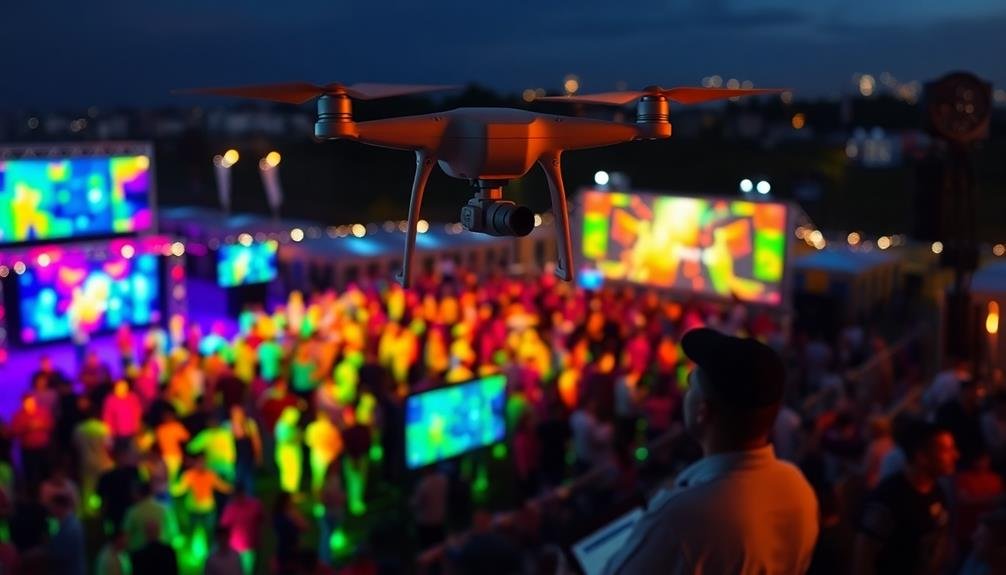
Thermal imaging technology takes drone-powered crowd safety to new heights. By equipping drones with thermal cameras, you'll be able to detect potential emergencies that aren't visible to the naked eye. These cameras can identify individuals with elevated body temperatures, which may indicate illness or distress. You'll also spot heat signatures from fires or overheating equipment before they become dangerous.
In large crowds, thermal imaging helps you locate lost children or vulnerable individuals who may be at risk. You'll easily distinguish between the cooler surroundings and the warmer human bodies, making it simpler to track movement patterns and identify anomalies. This technology proves particularly useful in low-light conditions or at night when traditional cameras struggle.
You'll find that thermal imaging drones can quickly scan vast areas, providing real-time data to event security teams. They'll help you detect unauthorized entry attempts by identifying heat signatures in restricted zones.
Furthermore, you'll be able to monitor queue temperatures, ensuring attendees aren't overheating while waiting in line. With this advanced technology, you're better equipped to prevent and respond to emergencies, greatly enhancing overall crowd safety at events.
AI-Powered Behavior Pattern Recognition
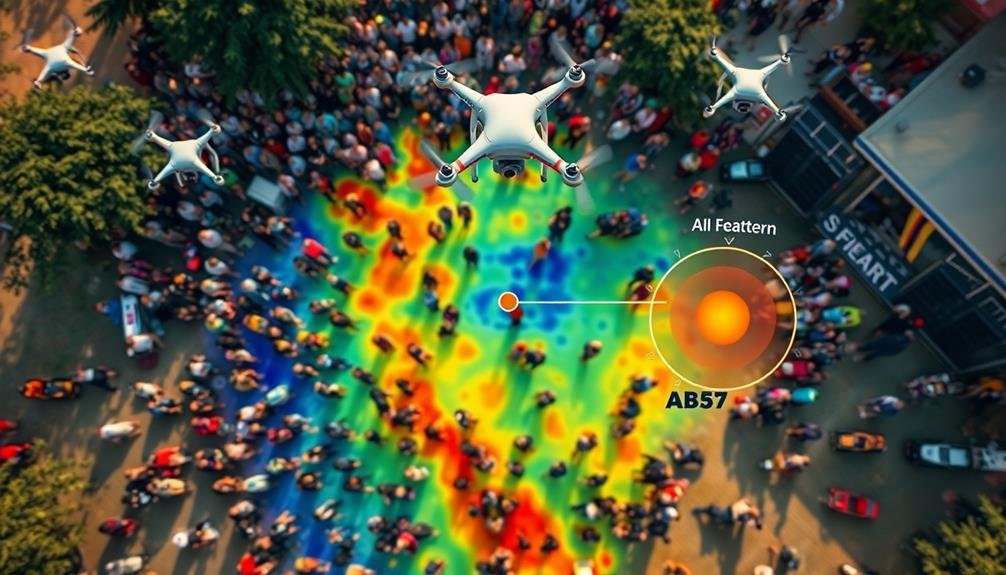
AI-powered behavior pattern recognition takes drone surveillance to the next level. You'll find that this technology enables drones to analyze crowd movements and identify potential security risks in real-time.
By utilizing machine learning algorithms, drones can detect unusual patterns or behaviors that might indicate danger, such as sudden crowd dispersals or aggressive actions.
You'll appreciate how these systems can differentiate between normal crowd activities and potentially threatening situations. They're trained on vast datasets of crowd behavior, allowing them to recognize subtle cues that human observers might miss.
When a drone detects an anomaly, it can immediately alert security personnel, enabling faster response times and more targeted interventions.
This technology isn't limited to identifying threats; it's also useful for crowd management. You can use it to predict bottlenecks, optimize event layouts, and guarantee smoother crowd flow.
By analyzing historical data and real-time information, AI-powered drones can suggest proactive measures to prevent overcrowding or congestion before they occur.
As this technology continues to evolve, you'll see improvements in accuracy and the ability to recognize increasingly complex behavior patterns, further enhancing event safety and management capabilities.
Rapid Response Coordination

You'll find that rapid response coordination is essential for effective crowd management.
Real-time incident alerts from drones can instantly notify security personnel of potential threats or emergencies.
These alerts enable you to swiftly deploy emergency resources, such as medical teams or law enforcement, to precisely where they're needed most in the crowd.
Real-Time Incident Alerts
When seconds count, real-time incident alerts can make all the difference. With drone-powered crowd safety systems, you'll receive immediate notifications about potential threats or emergencies as they unfold.
These alerts are triggered by the drones' advanced sensors and AI algorithms, which constantly analyze the crowd for signs of distress, conflicts, or unusual behavior.
You'll get instant updates on your mobile device or command center display, complete with precise location data and incident details. This allows you to assess the situation quickly and deploy resources effectively.
The alerts may include live video feeds from the drones, giving you eyes on the scene before first responders arrive.
Real-time incident alerts also enable you to coordinate with other security personnel and emergency services seamlessly. You can share information instantly, ensuring everyone's on the same page.
This rapid communication helps prevent small issues from escalating into major incidents.
Coordinated Emergency Resource Deployment
Thanks to drone-powered crowd safety systems, coordinating emergency resources has never been more efficient. When an incident occurs, you'll see drones automatically relaying real-time information to emergency responders. This data includes precise locations, crowd density, and potential obstacles, allowing for swift and targeted deployment of resources.
You'll notice how the system prioritizes and directs various emergency units. Police, medical teams, and fire departments receive instant, customized instructions based on the nature and severity of the incident. The drones' bird's-eye view helps identify the fastest and safest routes for responders to reach the affected areas.
As the situation unfolds, you'll observe how drones continue to monitor and update information. This enables dynamic resource allocation, ensuring that the right personnel and equipment are always where they're needed most. The system's AI can predict potential escalations or secondary incidents, allowing for proactive resource positioning.
You'll also see how drones facilitate communication between different emergency units, enhancing coordination and reducing response times. This integrated approach considerably improves the overall effectiveness of emergency operations in crowded events.
Data Integration With Ground Teams

You'll find that real-time communication channels are essential for seamless data integration between drones and ground teams.
By establishing coordinated response protocols, you can guarantee that critical information flows quickly and efficiently from aerial observers to personnel on the ground.
Your team's effectiveness in managing crowd safety will markedly improve as you leverage these integrated systems to make informed decisions and take swift action.
Real-time Communication Channels
How can drone-collected data be effectively integrated with ground teams to enhance crowd safety? Real-time communication channels play a significant role in this process.
You'll need to establish robust, secure networks that allow for instant data transmission between drones and ground personnel. Consider implementing encrypted radio frequencies or dedicated mobile apps for seamless information exchange.
These channels should support both voice communication and data transfer, enabling ground teams to receive live video feeds, thermal imagery, and crowd density maps from the drones. You'll want to guarantee that the communication system is resistant to interference and can function in high-traffic environments.
Equip your ground teams with ruggedized tablets or smartphones that can display drone-captured data overlaid on event maps. This will help them quickly identify potential issues and respond effectively.
Don't forget to implement a clear protocol for data interpretation and decision-making based on drone intel. Regular training sessions for both drone operators and ground personnel will guarantee everyone's on the same page when it comes to using these communication channels effectively in high-pressure situations.
Coordinated Response Protocols
Establishing effective communication channels is only the first step in leveraging drone data for crowd safety. You'll need to implement coordinated response protocols to guarantee that ground teams can effectively utilize the information gathered by drones. These protocols should outline specific actions to be taken based on different scenarios observed from the aerial perspective.
Start by creating a clear chain of command for decision-making during events. Assign roles and responsibilities to team members, including drone operators, data analysts, and ground security personnel. Develop a set of predefined response plans for common situations, such as crowd congestion, medical emergencies, or security threats.
Train your ground teams to interpret drone-provided data quickly and accurately. Implement a system for prioritizing and categorizing incoming information to facilitate rapid decision-making. Use color-coded alerts or numerical scales to indicate the severity of different situations.
Establish protocols for seamless integration between drone operators and ground teams. This includes procedures for guiding responders to specific locations using aerial imagery and coordinates.
Regularly conduct drills and simulations to test and refine these protocols, guaranteeing that your team can respond swiftly and effectively to any situation that may arise during an event.
Privacy Concerns and Legal Considerations
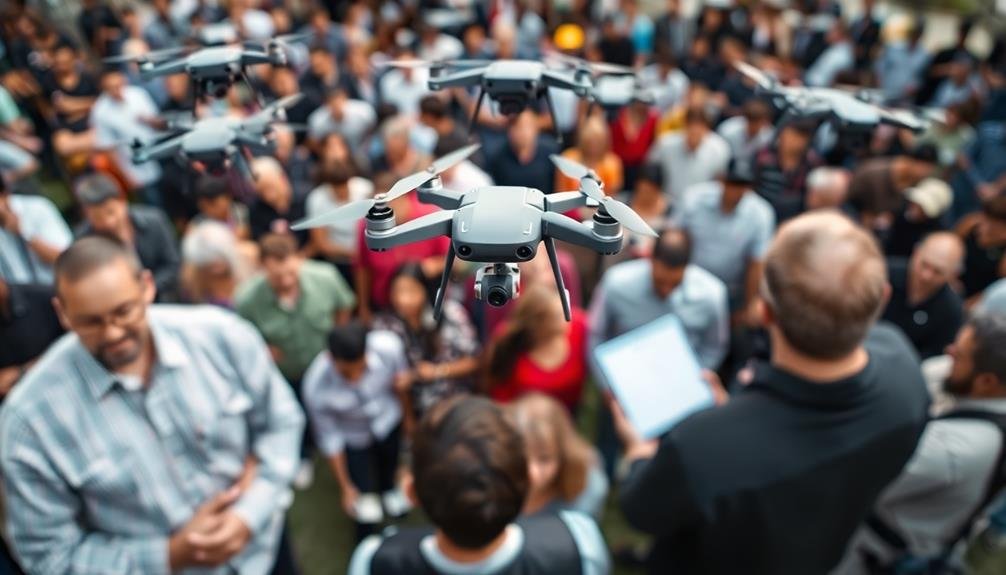
Numerous privacy concerns and legal considerations arise when deploying drones for crowd safety. You'll need to address issues like data collection, storage, and usage, as well as comply with local and federal regulations. It's vital to implement strict protocols for drone operations and data handling to protect individuals' privacy rights.
Consider the following key aspects:
| Privacy Concerns | Legal Considerations | Mitigation Strategies |
|---|---|---|
| Data Collection | FAA Regulations | Transparent Policies |
| Image Capture | Local Laws | Data Encryption |
| Facial Recognition | Privacy Acts | Limited Data Retention |
| Data Storage | Consent Requirements | Anonymization Techniques |
| Information Sharing | Liability Issues | Regular Audits |
You must guarantee that your drone operations adhere to all applicable laws, including obtaining necessary permits and certifications. It's important to develop clear policies on data usage, retention, and deletion. You should also implement robust security measures to prevent unauthorized access to collected information.
To maintain public trust, you'll need to be transparent about your drone usage and data practices. Educate event attendees about the presence of drones and their purpose. By addressing these concerns proactively, you can harness the benefits of drone technology for crowd safety while respecting individual privacy rights.
Frequently Asked Questions
How Do Drones Communicate With Each Other During Large-Scale Events?
During large-scale events, drones communicate with each other using radio frequency signals, WiFi, or cellular networks. They're equipped with advanced software that allows them to share data, coordinate movements, and relay information in real-time to guarantee efficient coverage.
What Backup Systems Are in Place if Drone Technology Fails?
You'll find multiple backup systems in place. Ground-based surveillance cameras, security personnel, and mobile command centers are ready to take over. There's also redundancy within the drone network itself, allowing other drones to compensate if one fails.
Can Drones Be Used for Crowd Control or Only for Monitoring?
Drones can be used for both monitoring and crowd control. You'll find they're effective for observing crowds, but they're also capable of dispersing people using audio messages, lights, or even non-lethal deterrents. Always consider ethical implications.
How Are Drone Operators Trained for Event Security Missions?
You'll undergo specialized training for drone operation in event security. You're taught flight controls, safety protocols, crowd behavior analysis, and emergency response procedures. You'll practice scenarios, learn relevant laws, and receive certification before real-world deployment.
What Measures Protect Drones From Hacking or Interference During Events?
You'll find drones protected by encrypted communications, GPS spoofing detection, and anti-jamming tech. They're equipped with fail-safe protocols, secure data links, and frequent software updates. Some use blockchain for added security during events.
In Summary
You've seen how drones are revolutionizing event security. They're not just eyes in the sky; they're your high-tech guardians. With real-time analysis, thermal imaging, and AI, you're safer than ever. But remember, this power comes with responsibility. As you embrace these innovations, don't forget to contemplate privacy and legal issues. Drone-powered crowd safety is here to stay, and it's up to you to use it wisely.

As educators and advocates for responsible drone use, we’re committed to sharing our knowledge and expertise with aspiring aerial photographers.




Leave a Reply